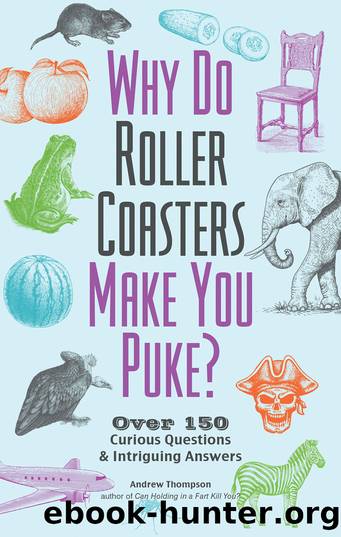Why Do Roller Coasters Make You Puke? by Andrew Thompson

Author:Andrew Thompson
Language: eng
Format: epub
ISBN: 9781612437392
Publisher: Ulysses Press
Published: 2017-07-07T00:00:00+00:00
Why Didnât People Smile in Old Photos?
Historical accounts say that Charles Darwin was very friendly, Abraham Lincoln had a humorous persona, and Mark Twain was armed with a sharp wit. But anybody looking at photographs of these three would assume they were the most serious and gloomy men who ever lived. In the photos of today, people smile and laugh, desperate to show how happy and social they are. Why did our ancestors appear so disconsolate when being photographed?
Some claim that people of yesteryear froze in their photos to allow for the longer exposure times in the cameras, or that they didnât want to show off their rotting teeth. Both of these suggestions are unlikely. And while times were often financially harder when photography began, itâs not as if laughter and mirth did not existâcarnivals and court jesters were the order of the day, so people loved to have a good time.
The reasons lie in the attitudes to both smiling and portraiture that existed in that era.
While today we think of smiles as being an indication of humor and happiness, in the 1800s it was believed that people who smiled a lot were poor, drunk, or simple. Those of higher standing and character did not readily smile in public.
In addition to that, it was traditional for people not to smile when having their portrait painted. In the early days of photography, having a photograph taken was not dissimilar to having a portrait doneâit was a rare occurrence, and for many people, it was a once-in-a-lifetime experience. People understood being photographed as a significant moment, intended as a timeless record of a person, much like a portrait was. Technology had given people the chance to be âpaintedâ like a king, and they took it very seriously. As Mark Twain once wrote, âA photograph is a most important document, and there is nothing more damning to go down to posterity than a silly, foolish smile caught and fixed forever.â
The question then becomes, why did we start smiling in photos?
By the early 1900s, in an attempt to associate their products with happiness and good times, companies used pictures of smiling models in their marketing campaigns. Kodak was no exception. They advertised heavily with smiling models, emphasizing the pleasure of the photograph. People soon began smiling in photos and the trend continued to modern times.
Download
This site does not store any files on its server. We only index and link to content provided by other sites. Please contact the content providers to delete copyright contents if any and email us, we'll remove relevant links or contents immediately.
The Infinite Retina by Robert Scoble Irena Cronin(6198)
Harry Potter and the Cursed Child: The Journey by Harry Potter Theatrical Productions(4445)
The Sports Rules Book by Human Kinetics(4304)
Molly's Game: From Hollywood's Elite to Wall Street's Billionaire Boys Club, My High-Stakes Adventure in the World of Underground Poker by Molly Bloom(3487)
A Knight of the Seven Kingdoms by George R R Martin(3195)
Quidditch Through the Ages by J.K. Rowling(3065)
How To by Randall Munroe(3040)
Flowers For Algernon by Daniel Keyes(3021)
Quidditch Through the Ages by J K Rowling & Kennilworthy Whisp(2930)
Quidditch Through the Ages by Kennilworthy Whisp by J.K. Rowling(2816)
Stacked Decks by The Rotenberg Collection(2812)
Quidditch through the Ages by J. K. Rowling(2769)
Quidditch Through The Ages by J. K. Rowling(2730)
776 Stupidest Things Ever Said by Ross Petras(2705)
Ready Player One: A Novel by Ernest Cline(2652)
What If?: Serious Scientific Answers to Absurd Hypothetical Questions by Randall Munroe(2639)
Beautiful Oblivion by Jamie McGuire(2573)
The Book of Questions: Revised and Updated by Gregory Stock Ph.d(2518)
Champions of Illusion by Susana Martinez-Conde & Stephen Macknik(2417)
